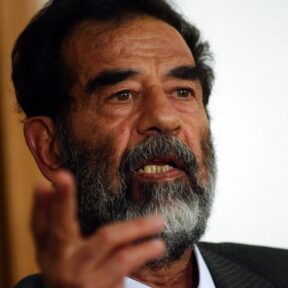
Saddam Hussein
: Photo from Wikimedia Commons / Author of Photo: Unknown authorOverview
* President of Iraq from 1979-2003
* Brutal dictator infamous for the torture and mass murder of his political opponents, real or imagined
* Deposed by U.S.-led invasion of Iraq in 2003
* Executed by hanging on December 30, 2006
Saddam Hussein was born in the Tikrit District of Iraq in 1937. He joined the Ba’ath Party in 1957 and participated in the attempted assassination of Prime Minister Abdul Karim Qassim in 1959. After the failure of the coup, he fled to Syria, then Cairo, where he attended law school at the University of Cairo. Saddam returned to Iraq in 1963 but was jailed for revolutionary activities the next year. He escaped from jail, ascended to the vice presidency of Iraq after the successful coup of Ahmed Hassan al-Bakr in 1968, became general of Iraq’s armed forces in 1976, and succeeded Hassan as president of Iraq in 1979.
Upon his succession, Saddam ordered the immediate execution of potential Ba’athist opponents. He maintained a Department of General Intelligence as the enforcement arm of his state security apparatus, using it to root out and annihilate enemies, real or imagined, local or overseas, of the his regime. Saddam began a campaign to eliminate Kurdish opposition in the north of Iraq, even going so far as to bomb Kurdish villages in Iran, one of several factors that escalated hostilities with Iran and led eventually to the Iran-Iraq War, in which Saddam used chemical weapons against both Kurdish separatists and the Iranian army.
Overburdened with debt from the war, which ran from 1980-1988, and encouraged by those within his own state who believed that Kuwait was historically a part of Iraq rather than an independent nation, Saddam ordered the invasion and annexation of Kuwait in 1990; a U.S. led coalition forced Saddam out of Kuwait in 1991, but did not overthrow the regime. The U.S. did encourage various segments of Iraqi society to rebel against Saddam’s rule, but did not militarily assist any such revolutions. Saddam restored his authority ruthlessly, suppressing the Kurds in the north and Shi’ites in the south of the country.
Proof that Saddam was connected to al Qaeda and other terrorist organizations, including Hamas, and allegations that Hussein was constructing and concealing weapons of mass destruction, led to the Second Gulf War and the overthrow of Saddam in 2003. He was arrested in December 2003 and was subsequently tried for war crimes.
Saddam promised to unleash “the mother of all wars” if the U.S. attempted to evict him from Kuwait. In the U.S. invasion that followed, some 100,000 members of his military forces were killed, another 175,000 were captured, and virtually the entire Iraqi air force defected to Iran.
During his reign, Saddam was a major supporter of terrorism. He offered $25,000 apiece to the families of PLO and Hamas suicide bombers, and at various times he supported, and was supported by, al-Qaeda and other extremist groups.
Saddam was captured in Iraq by U.S. forces in December 2003. An Iraqi court subsequently tried and convicted him of war crimes, and he was executed by hanging on December 30, 2006.